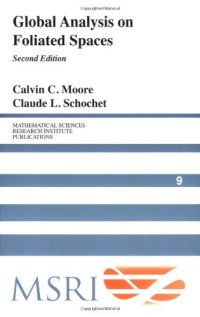
Ebook: Global Analysis on Foliated Spaces
- Genre: Mathematics
- Tags: Algebraic Topology, Theoretical Mathematical and Computational Physics
- Series: Mathematical Sciences Research Institute Publications 9
- Year: 1988
- Publisher: Springer-Verlag New York
- City: New York
- Edition: 1
- Language: English
- pdf
Global analysis has as its primary focus the interplay between the local analysis and the global geometry and topology of a manifold. This is seen classicallv in the Gauss-Bonnet theorem and its generalizations. which culminate in the Ativah-Singer Index Theorem [ASI] which places constraints on the solutions of elliptic systems of partial differential equations in terms of the Fredholm index of the associated elliptic operator and characteristic differential forms which are related to global topologie al properties of the manifold. The Ativah-Singer Index Theorem has been generalized in several directions. notably by Atiyah-Singer to an index theorem for families [AS4]. The typical setting here is given by a family of elliptic operators (Pb) on the total space of a fibre bundle P = F_M_B. where is defined the Hilbert space on Pb 2 L 1p -llbl.dvollFll. In this case there is an abstract index class indlPI E ROIBI. Once the problem is properly formulated it turns out that no further deep analvtic information is needed in order to identify the class. These theorems and their equivariant counterparts have been enormously useful in topology. geometry. physics. and in representation theory.
Foliated spaces look locally like products, but their global structure is generally not a product, and tangential differential operators are correspondingly more complex. In the 1980s, Alain Connes founded what is now known as noncommutative geometry. One of the first results was his generalization of the Atiyah-Singer index theorem to compute the analytic index associated with a tangential (pseudo)-differential operator and an invariant transverse measure on a foliated manifold, in terms of topological data on the manifold and the operator. This book presents a complete proof of this beautiful result, generalized to foliated spaces (not just manifolds).